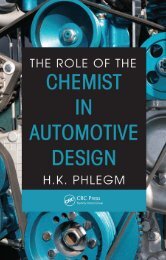Lightweight Electric/Hybrid Vehicle Design
Lightweight Electric/Hybrid Vehicle Design
Lightweight Electric/Hybrid Vehicle Design
You also want an ePaper? Increase the reach of your titles
YUMPU automatically turns print PDFs into web optimized ePapers that Google loves.
Introduction xxix<br />
conventional bicycles. <strong>Electric</strong> motorcycles are less common than electric scooters, the BMW<br />
C1 being an example. Recent electric cars have divided between conversions of standard<br />
production models and a small number of purpose built vehicles. Japan’s flourishing microcar<br />
market of smaller and lighter cars is an important target group for electric conversion, for which<br />
acceleration and efficient stop-start driving is more important than range. Such city cars are<br />
distinct from longer-range inter-urban cars and the latter market currently attracts hybrid drive<br />
cars of either gasoline or diesel auxiliary engines, with series or parallel drive configurations.<br />
Fuel-cell cars for the inter-urban market are still mostly in the development stage of value<br />
engineering for volume production.<br />
Commercial and passenger service vehicle applications, that section of the market where<br />
downtime has to be kept to a minimum, and where low maintenance costs are at a premium, are<br />
particularly attractive to EVs. Municipal vehicles operating in environmentally sensitive zones<br />
are other prime targets. In passenger service applications battery-electric minibuses are a common<br />
application in city centres and IC-electric hybrids are increasingly used for urban and suburban<br />
duties. Gas-turbine/electric hybrids have also been used in buses and fuel-cell powered drives.<br />
Guided buses include kerb-guided and bus/tram hybrids, the former having the possibility for<br />
dual-mode operation as conventionally steered vehicles. Guided buses have been used in Essen<br />
since 1980. Trolleybus and tramway systems are also enjoying a comeback.<br />
At this relatively early stage in development of new generation EVs tabular classification is<br />
difficult with probably the only major variant being traction battery technology. A useful comparison<br />
was provided in a Financial Times report 6 on ‘The future of the electric vehicle’ as follows:<br />
Battery Advantages Disadvantages Comments<br />
Lead–acid Established Low energy and Horizon and other high<br />
technology; low cost power density. performance batteries<br />
and fairly long life greatly improve the<br />
(1000 cycles). suitability for EVs but<br />
must be made cheaper.<br />
Nickel– Higher energy density Cadmium very Being used for second<br />
cadmium and cycle life than toxic. generation, purposelead–acid.<br />
built EVs.<br />
Lithium High energy and Expensive. Research into scaling<br />
power densities. up to EV size will<br />
Safety concerns probably provide a<br />
overcome. mid-term battery.<br />
Sodium– High efficiency and Thermal enclosure Several technical issues<br />
sulphur energy density. and thermal management to be resolved before<br />
is expensive. this could become an<br />
Corrosive components. option.<br />
Sodium– High energy and Thermal enclosure Promising mid-term<br />
nickel power densities. and thermal option but currently<br />
chloride Long life (over 1000 management are over twice the cost of<br />
cycles). expensive. the USABC target.<br />
Nickel–metal High power density, Expensive. Promising mid-term<br />
hydride Long cycle life (over option but currently<br />
2000 cycles). over twice the cost of<br />
Twice the energy the USABC target.<br />
storage of lead–acid.







